
Tracking Russian military equipment losses, Visualising and analyzing how that evolves in charts. Contributor to 'Tracking Russia’s losses' website.
7 subscribers
How to get URL link on X (Twitter) App


 2) Also the calibers of the lost Russian artillery has also changed, at the start about 2/3 of the losses were the standard 152mm guns Dark Blue). that has steadily decreased, and now represent just 11% of the total, mostly displaced by 122mm.
2) Also the calibers of the lost Russian artillery has also changed, at the start about 2/3 of the losses were the standard 152mm guns Dark Blue). that has steadily decreased, and now represent just 11% of the total, mostly displaced by 122mm. 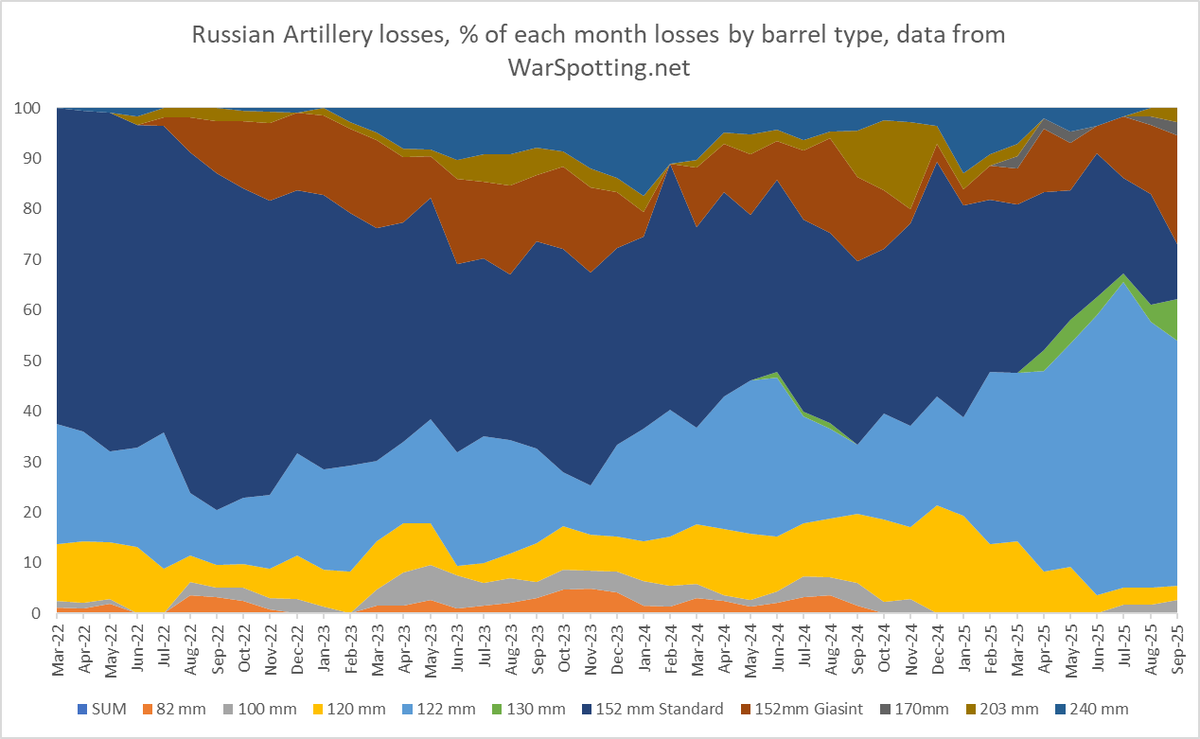
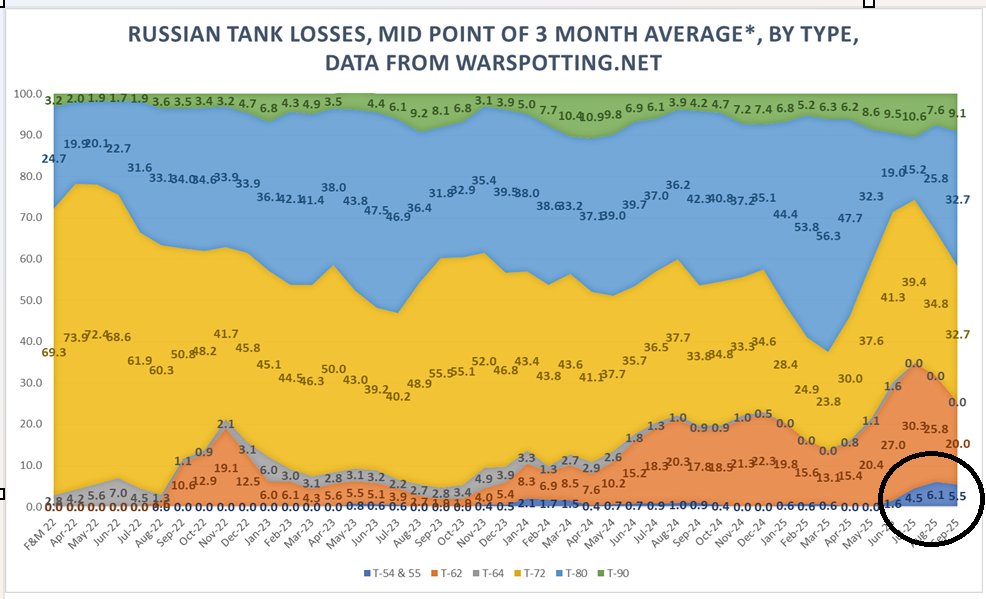
 2) There have been 88 total Russian tank losses over 3 months, but of these a quarter 22 have been of Unknown Type. Therefor, of the 66 lost tanks of Known types, the 4 T-54/55s represent 6% A small share, but not negligible, as they have been up to now.
2) There have been 88 total Russian tank losses over 3 months, but of these a quarter 22 have been of Unknown Type. Therefor, of the 66 lost tanks of Known types, the 4 T-54/55s represent 6% A small share, but not negligible, as they have been up to now. 

 2) I don't have any inside knowledge of Russian tactics, and 'loss analysis' always has limitations, so recognising those limitations, I'm not going to say why this is. But those that are suggesting that Russia might have stopped supporting small assaults with IFVs and instead are now doing small numbers of larger assaults, might be right.
2) I don't have any inside knowledge of Russian tactics, and 'loss analysis' always has limitations, so recognising those limitations, I'm not going to say why this is. But those that are suggesting that Russia might have stopped supporting small assaults with IFVs and instead are now doing small numbers of larger assaults, might be right.

 2) T-90 losses are now exclusively T-90Ms, only 2 T-90As have been lost this year, the last in April. This reinforces my long held assumption that Russia has been upgrading there T-90As to T-90Ms, And probably means they are now few if any T-90As left, new T-90M production is probably back to 60-80 a year.
2) T-90 losses are now exclusively T-90Ms, only 2 T-90As have been lost this year, the last in April. This reinforces my long held assumption that Russia has been upgrading there T-90As to T-90Ms, And probably means they are now few if any T-90As left, new T-90M production is probably back to 60-80 a year.
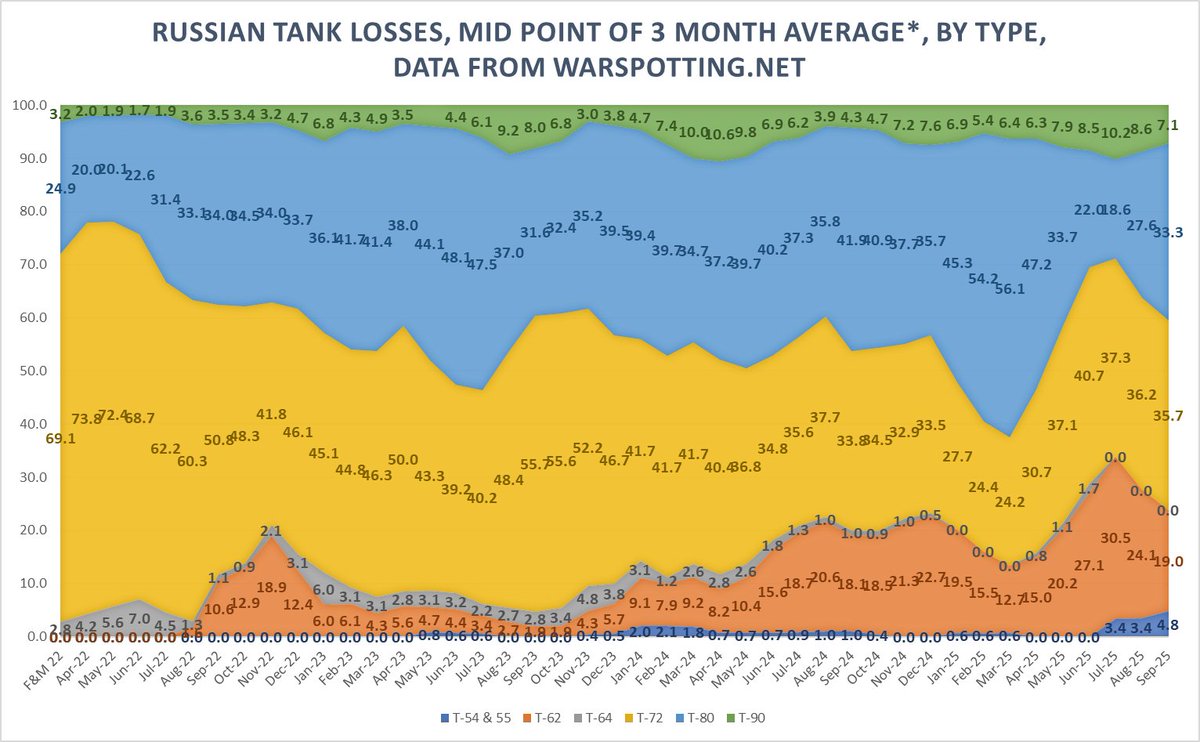
 2) this striking chart is perhaps the big news from this months Russi losses, it shows the ratio of Tanks to IFVs, we have gone form 2-3 IFV/APCs for each tank lost to less than half an IFV/APC to each tank lost.
2) this striking chart is perhaps the big news from this months Russi losses, it shows the ratio of Tanks to IFVs, we have gone form 2-3 IFV/APCs for each tank lost to less than half an IFV/APC to each tank lost. 

 2) Here in table format, only 6 IFV/APCs (yellow) but 37 transport (orange).
2) Here in table format, only 6 IFV/APCs (yellow) but 37 transport (orange).
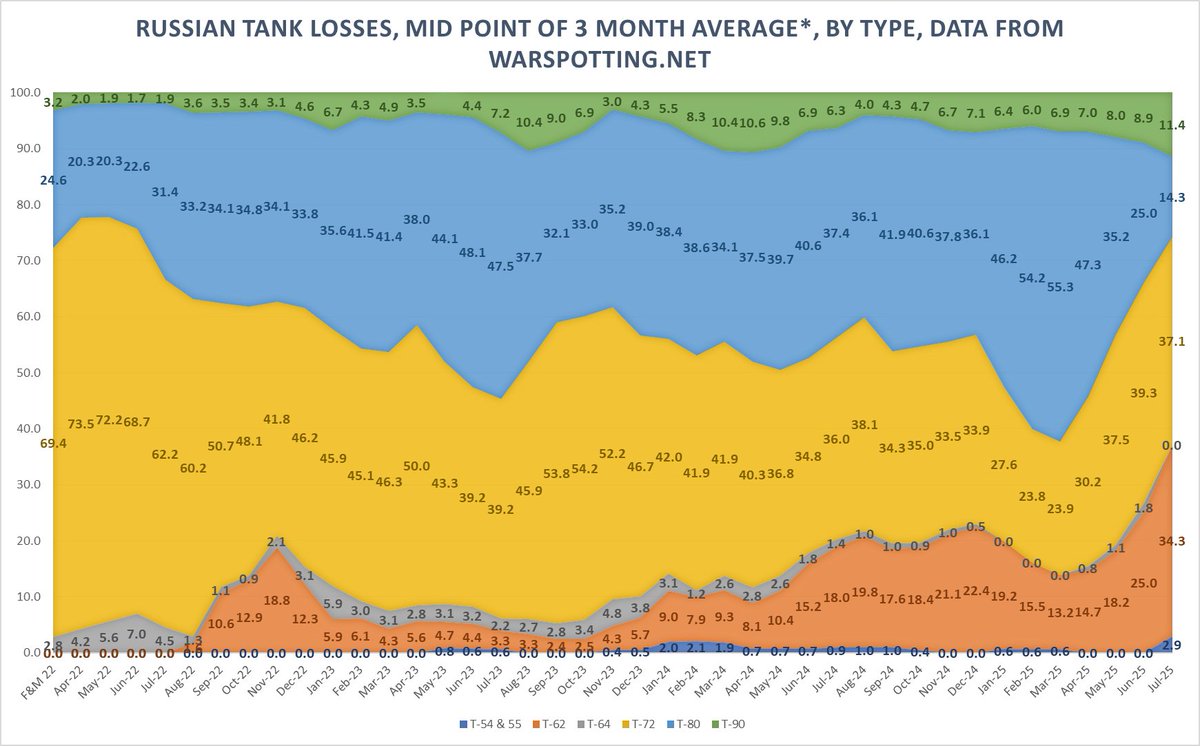
 2) This graph is the same data as the first graph, but without the '3 month averaging'. T-62s and T-90s look like significant increase but their numbers are stedy, T-72s have declined proportionately to the overall reduction so there share is about the same.
2) This graph is the same data as the first graph, but without the '3 month averaging'. T-62s and T-90s look like significant increase but their numbers are stedy, T-72s have declined proportionately to the overall reduction so there share is about the same. 
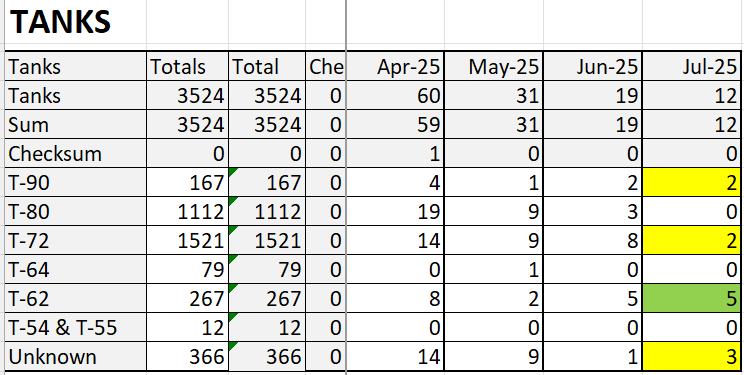
 2)
2) 
 2) The first graph does not include 'Unknown Tank' which have been increasing and were over 25% in May (Black in this graph) this adds an extra layer of uncertainty on this, but I will persevere anyway.
2) The first graph does not include 'Unknown Tank' which have been increasing and were over 25% in May (Black in this graph) this adds an extra layer of uncertainty on this, but I will persevere anyway. 

 2) They are still less than 2% of all Russian IFV/APC losses, but they are now over 20% of BMP-1 Based vehicles losses.
2) They are still less than 2% of all Russian IFV/APC losses, but they are now over 20% of BMP-1 Based vehicles losses. 

 2) If we look at losses for the first week of April, they are down to just 2.2% of the total IFV/APC losses. I've added this week to the graph and posted here, but posting it in the second tweet in🧵so I'm not being too sensational.
2) If we look at losses for the first week of April, they are down to just 2.2% of the total IFV/APC losses. I've added this week to the graph and posted here, but posting it in the second tweet in🧵so I'm not being too sensational. 

 2) The T-80s are the most significant type, so I will start with them. T-80U losses have been minimal for two years now, but there seems to be a relatively consistent rate of change to the Orb 2022 variants. If this continues, then all the old ones will be gone around Jul/Aug.
2) The T-80s are the most significant type, so I will start with them. T-80U losses have been minimal for two years now, but there seems to be a relatively consistent rate of change to the Orb 2022 variants. If this continues, then all the old ones will be gone around Jul/Aug. 
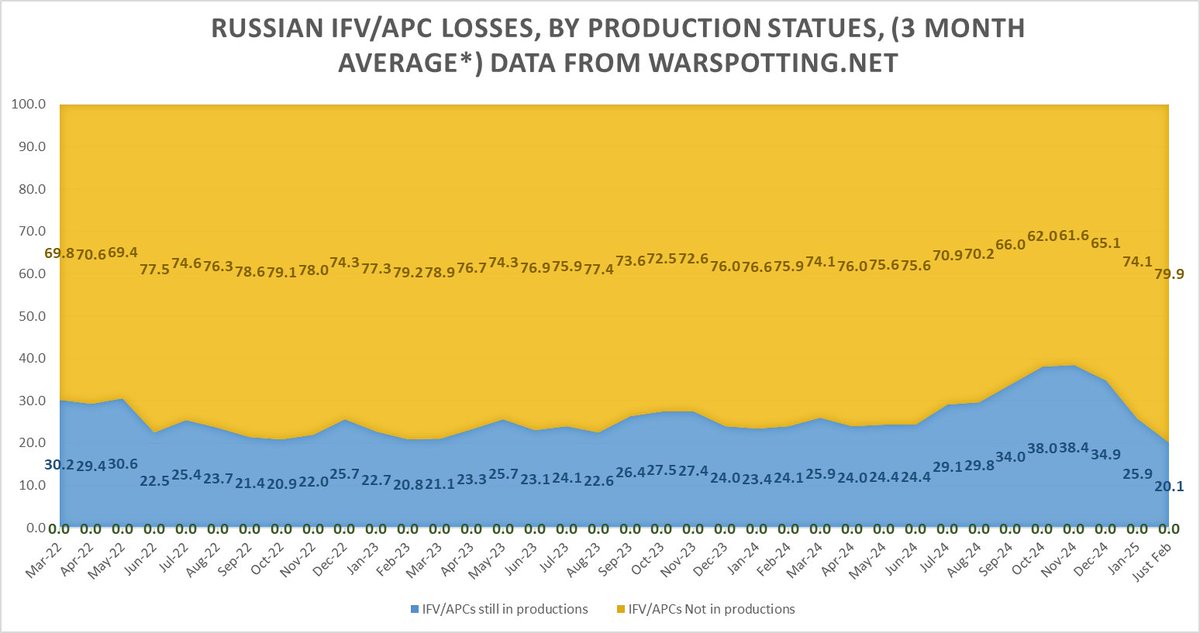
 2) By types still in production, I mean the IFV BMP-3, the air mobile IFV BMP-3 and the wheeled IFV/PC crossover BTR-82.
2) By types still in production, I mean the IFV BMP-3, the air mobile IFV BMP-3 and the wheeled IFV/PC crossover BTR-82. 
 2) Overall, Russia is only visually confirmed to have lost 151 T-90s, but a portion of the 333 'Unknown Tanks' will also be T-90s, and others will have been lost and not photographed. At any point in time, there will be some damaged tanks that will need repairs.
2) Overall, Russia is only visually confirmed to have lost 151 T-90s, but a portion of the 333 'Unknown Tanks' will also be T-90s, and others will have been lost and not photographed. At any point in time, there will be some damaged tanks that will need repairs. 

 2) I left December off the graphs and predicted a little differently. This showed what I think is the trend.
2) I left December off the graphs and predicted a little differently. This showed what I think is the trend. 

 2) Tanking about records, Russia is losing a record-high number of IFVs for each Tank it is losing. There could be a few reasons for this, including the fact that they don't have that many working tanks anymore. But more about that latter.
2) Tanking about records, Russia is losing a record-high number of IFVs for each Tank it is losing. There could be a few reasons for this, including the fact that they don't have that many working tanks anymore. But more about that latter. 
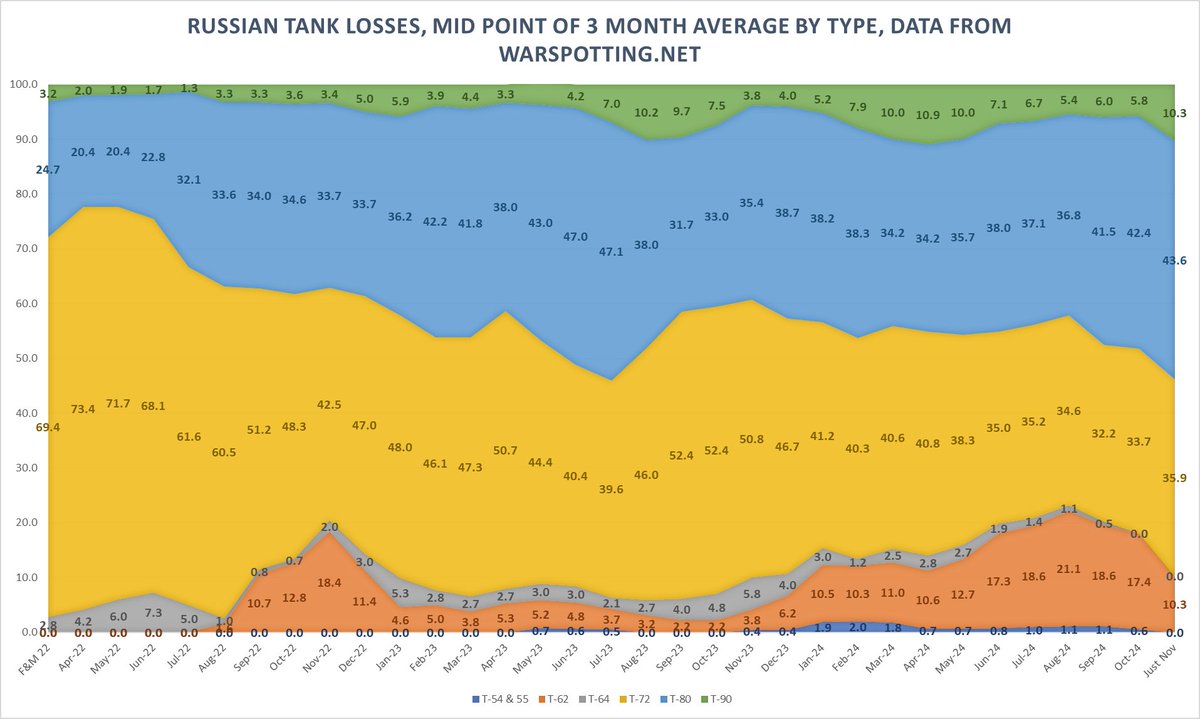
 2) The loss ratio of Russian IFVs to Russian Tanks, has stabilized at 3.5 to 1. So the spike we witnessed in September was likely not an out-lyer. Perhaps this is the new normal now?
2) The loss ratio of Russian IFVs to Russian Tanks, has stabilized at 3.5 to 1. So the spike we witnessed in September was likely not an out-lyer. Perhaps this is the new normal now? 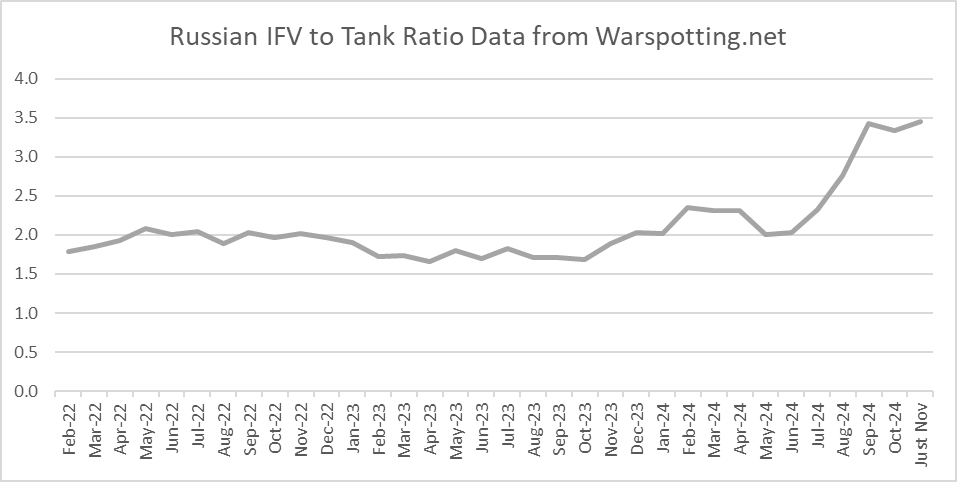

 2) The percentage of IFV/APCs in production increased from 24.3% in April to 43.8% in Nov. Showing a steady but significant change. This could be because:
2) The percentage of IFV/APCs in production increased from 24.3% in April to 43.8% in Nov. Showing a steady but significant change. This could be because:
 2) This month has not seen dramatic change, but there are trends,
2) This month has not seen dramatic change, but there are trends, 
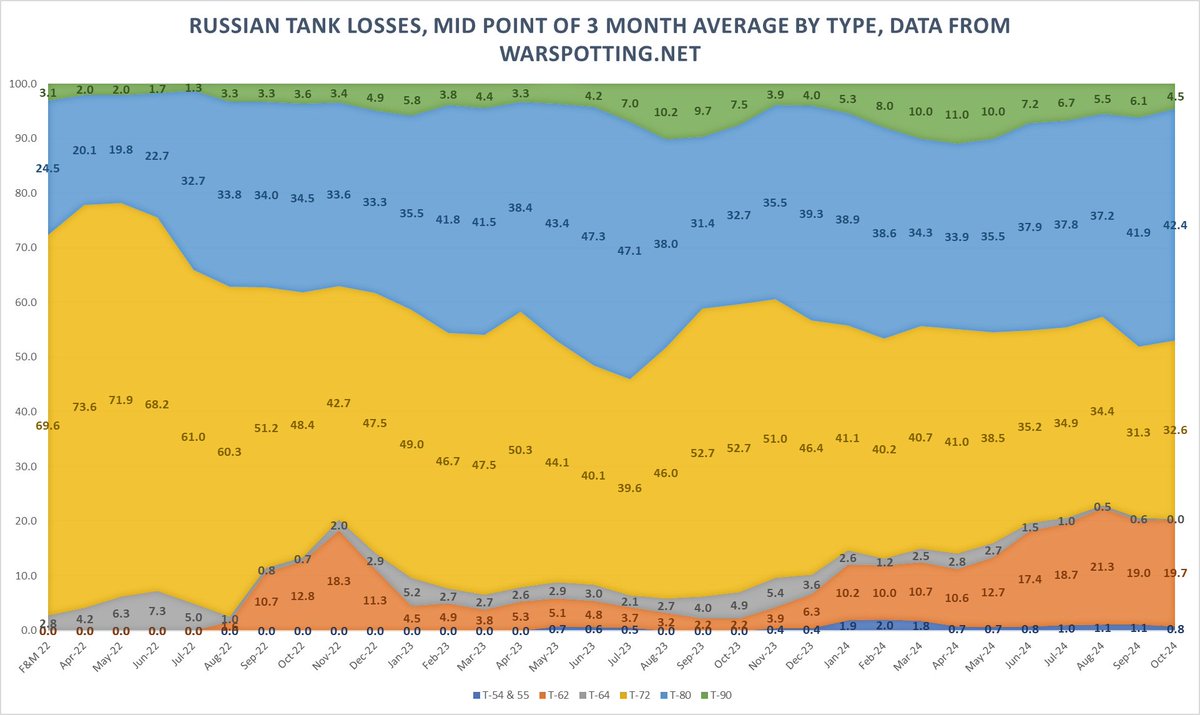
 2) I don't know why T-62s have stopped increasing, perhaps it's random, or maybe they have now used up all the 'easily to repair' T-62s. Looking at the variants of T-62 does not show a lot, most are still T-62Ms (grey) with slightly more T-62M Obr 2022s than before. (yellow)
2) I don't know why T-62s have stopped increasing, perhaps it's random, or maybe they have now used up all the 'easily to repair' T-62s. Looking at the variants of T-62 does not show a lot, most are still T-62Ms (grey) with slightly more T-62M Obr 2022s than before. (yellow) 

 2) First I should say the above graph uses the midpoint of each 3-month period, i.e. Feb is, Jan, Feb, & Mar, Mar is Feb, Mar and Apr. The exception is in Oct 2024, which is just the first 16 days of October, so not a big sample, but as it's flowing the trend I've added it.
2) First I should say the above graph uses the midpoint of each 3-month period, i.e. Feb is, Jan, Feb, & Mar, Mar is Feb, Mar and Apr. The exception is in Oct 2024, which is just the first 16 days of October, so not a big sample, but as it's flowing the trend I've added it.